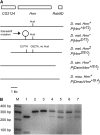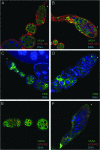Reduced fertility of Drosophila melanogaster hybrid male rescue (Hmr) mutant females is partially complemented by Hmr orthologs from sibling species
- PMID: 19153254
- PMCID: PMC2666511
- DOI: 10.1534/genetics.108.100057
Reduced fertility of Drosophila melanogaster hybrid male rescue (Hmr) mutant females is partially complemented by Hmr orthologs from sibling species
Abstract
The gene Hybrid male rescue (Hmr) causes lethality in interspecific hybrids between Drosophila melanogaster and its sibling species. Hmr has functionally diverged for this interspecific phenotype because lethality is caused specifically by D. melanogaster Hmr but not by D. simulans or D. mauritiana Hmr. Hmr was identified by the D. melanogaster partial loss-of-function allele Hmr1, which suppresses hybrid lethality but has no apparent phenotype within pure-species D. melanogaster. Here we have investigated the possible function of Hmr in D. melanogaster females using stronger mutant alleles. Females homozygous for Hmr mutants have reduced viability posteclosion and significantly reduced fertility. We find that reduced fertility of Hmr mutants is caused by a reduction in the number of eggs laid as well as reduced zygotic viability. Cytological analysis reveals that ovarioles from Hmr mutant females express markers that distinguish various stages of wild-type oogenesis, but that developing egg chambers fail to migrate posteriorly. D. simulans and D. mauritiana Hmr+ partially complement the reduced fertility of a D. melanogaster Hmr mutation. This partial complementation contrasts with the complete functional divergence previously observed for the interspecific hybrid lethality phenotype. We also investigate here the molecular basis of hybrid rescue associated with a second D. melanogaster hybrid rescue allele, In(1)AB. We show that In(1)AB is mutant for Hmr function, likely due to a missense mutation in an evolutionarily conserved amino acid. Two independently discovered hybrid rescue mutations are therefore allelic.
Figures




References
-
- Barbash, D. A., G. Johnson, J. Roote and M. Ashburner, 2004. b A new hybrid rescue allele in Drosophila melanogaster. Genetica 120 261–266. - PubMed
-
- Barbash, D. A., and J. G. Lorigan, 2007. Lethality in Drosophila melanogaster/Drosophila simulans species hybrids is not associated with substantial transcriptional misregulation. J. Exp. Zool. B Mol. Dev. Evol. 308B 74–84. - PubMed
Publication types
MeSH terms
Substances
Grants and funding
LinkOut - more resources
Full Text Sources
Medical
Molecular Biology Databases

